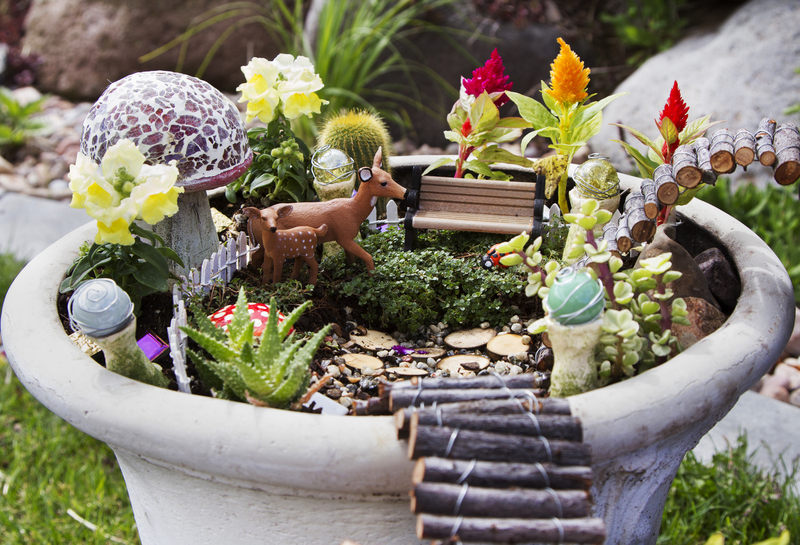Fortify Your Garden: Preventing Severe Weather Damage
Posted on 19/06/2025
Fortify Your Garden: Preventing Severe Weather Damage
A garden is not just a source of natural beauty and fresh produce--it's an oasis that reflects your dedication and care. However, your outdoor sanctuary can be vulnerable to the unpredictable fury of nature. Hailstorms, heavy rains, high winds, and temperature fluctuations can all threaten the health and appearance of your beloved plants. Luckily, with strategic preparation, fortifying your garden against severe weather damage is entirely possible. Below, you'll discover comprehensive and Google-friendly insights to help safeguard your greenery, maintain its lushness, and ensure long-term resilience.
Understanding Severe Weather Risks in Your Area
Effective garden fortification starts with knowledge. Before you can protect your garden, it's crucial to understand what kind of extreme weather your region faces most frequently.
- Heavy Rainfall: Prolonged downpours can cause soil erosion, waterlogging, and root rot.
- High Winds: Gale-force winds can break branches, uproot younger plants, and damage garden structures.
- Hail Storms: Hailstones can shred leaves, bruise fruits, and destroy delicate flowers.
- Frost and Freeze Events: Sudden cold snaps can kill or stunt non-hardy plants.
- Drought: Extended dry periods stress and weaken most plant species.
Research your local climate patterns and historical weather events. Websites from your local meteorological office, gardening forums, and extension services are excellent resources.

General Strategies to Strengthen Your Garden Structure
Proactive measures are key to minimizing potential weather-related harm. Here are fundamental steps for fortifying your garden:
1. Diversify Plant Selection
- Choose native or weather-resistant species that are specifically adapted to your region.
- Plant in groups to create windbreaks and microclimates; larger, hardy plants can shelter more delicate companions.
- Consider perennials with woody stems that endure harsh conditions better than annuals.
2. Improve Soil Structure and Drainage
- Add organic matter like compost or well-rotted manure to increase soil resilience and water retention.
- Create raised beds or install French drains to improve drainage in heavy rainfall zones.
- Mulch generously to stabilize soil temperature, reduce erosion, and protect roots.
3. Install Windbreaks and Protective Barriers
- Plant hedges, shrubs, or rows of evergreen trees to block prevailing winds.
- Use trellises, fences, or garden netting for immediate wind and hail protection.
- Temporary frost cloths or floating row covers can protect plants during unexpected cold snaps.
4. Secure Garden Structures
- Firm up arbors, pergolas, and fences by checking and reinforcing their foundations regularly.
- Store garden ornaments, tools, and loose materials before storms arrive.
- Anchor raised beds and container plants to prevent them from blowing away.
Specific Weather Threats: How to Prepare Your Garden
Preventing Wind Damage in Your Garden
High winds can uproot plants, snap stems, and cause structural damage. Windproofing your garden provides an essential layer of protection:
- Stake taller plants such as tomatoes, sunflowers, and young trees. Use flexible ties to avoid damaging stems.
- Install windbreak fencing: Choose semi-permeable materials like woven wood or fabric for optimal protection. Solid walls can create destructive eddies on the leeward side.
- For container plants, cluster pots together in a sheltered area and secure them with weights or barricades.
- Prune trees and shrubs to maintain strong, balanced growth and reduce top-heaviness.
Protecting Against Heavy Rain and Flooding
While rain is essential, excessive amounts can wash away nutrients and suffocate roots. To guard against rain-induced garden damage:
- Grade your garden beds to encourage runoff away from plant roots and structures.
- Install rain gardens or swales--shallow, planted channels that capture runoff and filter excess water.
- Use raised beds in low-lying or flood-prone areas for better drainage.
- Maintain gutters and downspouts to direct roof water far from your greenery.
- Regularly aerate your soil to minimize compaction, helping water to drain efficiently.
Mitigating Hail Damage
Hail is especially destructive to soft foliage and unprotected vegetables. Reduce hail damage risk with these steps:
- Install removable hail netting or mesh panels over vulnerable beds during stormy seasons.
- Grow under cold frames, hoop houses, or polytunnels for added physical protection.
- Plant robust species--like Swiss chard or kale--along more delicate crops as a living shield.
- Plan your planting schedule to avoid peak hail months if possible, especially for flowering and fruiting stages.
Guarding Against Frost and Sudden Cold Spells
Sudden dips in temperature cause cellular damage in non-hardy plants. Protect against frost and freezes by:
- Monitoring forecasts closely; cover plants with frost blankets or old sheets on cold nights.
- Watering soil before a freeze, as moist earth retains heat better than dry soil.
- Move portable containers into garages, sheds, or under eaves as needed.
- Mulching annual beds to insulate the roots from rapid temperature drops.
Coping with Drought and Hot Spells
Prolonged dry periods can devastate a garden. Enhance drought resistance through:
- Regular, deep watering early in the morning or late evening to minimize evaporation.
- Using drip irrigation or soaker hoses for efficient moisture delivery to roots.
- Applying thick organic mulch to shade soil and conserve moisture.
- Selecting drought-tolerant plant varieties and xeriscaping exposed areas.
Smart Garden Design Principles for Weather Resilience
Embedding weather-resilient features from the start makes all the difference. Employ these garden design tactics:
- Terrace steep slopes to slow water runoff and prevent erosion. Use stone walls or sturdy timber.
- Incorporate rainwater harvesting systems and proper drainage routes throughout your landscape.
- Create multi-layered plantings. A forest-style approach--with groundcovers, shrubs, and trees--offers built-in wind, hail, and sun protection.
- Leave buffer zones of tough grasses or wildflowers along fence lines--these absorb the brunt of extreme conditions.
- Ensure easy access paths to move quickly for emergency plant protection when extreme weather is forecasted.
Emergency Preparedness: Responding to Impending Storms
Sometimes, despite our best efforts, severe weather arrives with little warning. Here's how to prepare last-minute and minimize storm damage:
- Move vulnerable pots to the most sheltered spots or indoors if possible.
- Quickly reinforce plant supports and tie down loose trellises or netting.
- Harvest ripe produce and flowers--heavy rain or hail can ruin maturing crops overnight.
- Lay down extra mulch to shield roots from harsh winds or temperature drops.
- Cover prized plants with buckets, baskets, or fabric overnight if frost is forecasted.
Post-Storm Recovery and Assessment
After the weather clears, take these steps to help your garden bounce back:
- Remove debris and broken branches swiftly to prevent disease and pests.
- Assess plant damage: Prune broken stems with clean, sharp tools to encourage recovery.
- Water any dried-out or wind-battered plants--gentle soaking can revive root systems.
- Feed stressed plants lightly with diluted organic fertilizer for a boost.
- Reinforce damaged structures and make notes for future fortification improvements.
Tools and Products for Weather-Proof Gardens
Modern gardening technology and supplies make fortifying your garden against severe weather even more efficient:
- Hail netting and frost cloth: Lightweight, reusable materials offering instant protection for beds and borders.
- Sturdy stakes, cages, and trellises: Essential to support top-heavy plants and vines.
- Self-watering planters: These help maintain moisture during dry spells or when you can't water daily.
- Weather sensors and smart irrigation controllers: Automatically adjust watering schedules based on current and predicted conditions.
- Heavy-duty garden ties and clips to fasten stems and branches without injury.

Eco-Friendly Strategies for Sustainable Garden Protection
Protecting your garden from severe weather doesn't have to harm the planet. Embrace sustainability with these green practices:
- Utilize living windbreaks composed of native hedges or shrubs rather than artificial screens.
- Recycle materials--such as old fabric, lumber, or plastic bottles--to create homemade covers and barriers.
- Compost organic waste to fortify soil and help your garden recover after storms.
- Choose water-conserving and drought-resistant plant species for long-term, low-impact gardening.
- Practice integrated pest management to avoid chemical runoff after heavy rains.
Conclusion: A Resilient Garden for All Seasons
Severe weather is an inevitable challenge, but armed with foresight and time-tested strategies, you can fortify your garden against damage and ensure it thrives through rain, wind, hail, and drought. Regular assessment, smart plant selection, soil care, and targeted weather defence tactics combine to create a truly resilient outdoor space. Let your garden be a testament to both nature's beauty and your commitment to protection and sustainability.
Preparation today means peace of mind tomorrow. Start fortifying your garden now, and enjoy a haven that weathers every storm.
```
